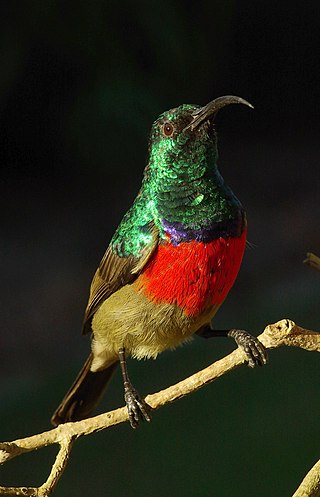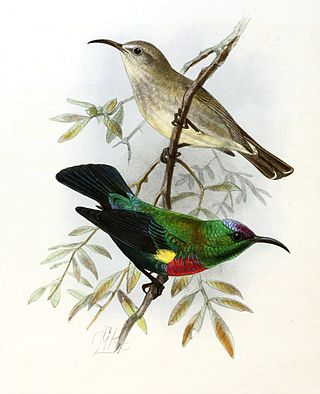
The beautiful sunbird, formerly placed in the genus Nectarinia, is a sunbird. It is native to tropical Africa, its range extending from Senegal and Guinea in the west to Sudan, South Sudan, Ethiopia, Tanzania and Kenya in the east.

The olive-backed sunbird, also known as the yellow-bellied sunbird, is a species of sunbird found from Southern Asia to Australia.

The purple sunbird is a small bird in the sunbird family found mainly in South and Southeast Asia but extending west into parts of the Arabian peninsula. Like other sunbirds they feed mainly on nectar, although they will also take insects, especially when feeding young. They have a fast and direct flight and can take nectar by hovering like a hummingbird but often perch at the base of flowers. The males can appear all black in harsh sunlight but the purple iridescence is visible on closer observation or under good light conditions. Females are olive above and yellowish below.

The greater double-collared sunbird, is a small bird in the sunbird family.

The Palestine sunbird is a small passerine bird of the sunbird family, Nectariniidae. Found in parts of the Middle East and sub-Saharan Africa, it is also known as the orange-tufted sunbird, a name also used for the similar Cinnyris bouvieri, found further south in Africa. In 2015, the Palestinian Authority adopted the species as a national bird. The specific name osea is derived from Ancient Greek ὁσια.

Bates's sunbird is a species of sunbird in the family Nectariniidae which occurs in Western African forests and Central African rainforests, and locally in other types of forest in Central Africa.

The olive-bellied sunbird is a species of bird in the family Nectariniidae. It is widely spread across African tropical rainforest.

The shining sunbird is a species of bird in the family Nectariniidae.

The eastern double-collared sunbird is a species of bird in the family Nectariniidae. It is found in upland areas of Kenya and northern Tanzania.

The northern double-collared sunbird, is a species of bird in the family Nectariniidae. It is found in Burundi, Cameroon, Central African Republic, Democratic Republic of the Congo, Equatorial Guinea, Kenya, Nigeria, Rwanda, South Sudan, and Uganda.

Shelley's sunbird is a species of bird in the family Nectariniidae. It is found in Democratic Republic of the Congo, Malawi, Mozambique, Tanzania, Zambia and Zimbabwe. The species is named after George Ernest Shelley, an English geologist and ornithologist and nephew of poet Percy Bysshe Shelley.

The Tsavo sunbird is a small passerine bird of Kenya and Tanzania. It is sometimes lumped with the purple-banded sunbird.











